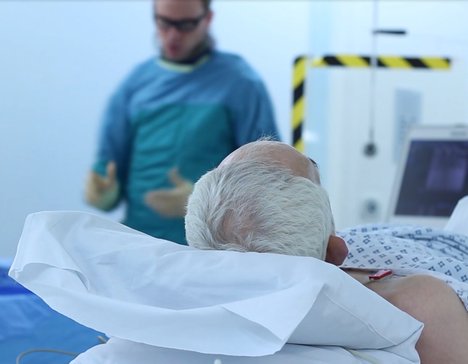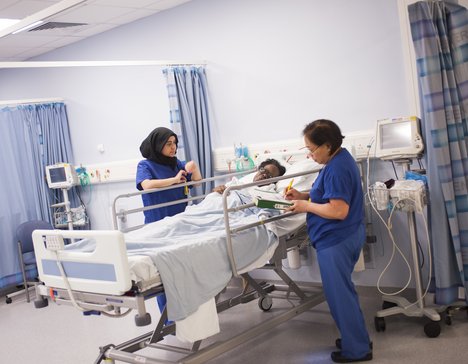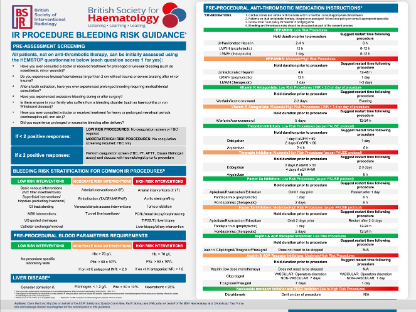Clinical Practice Guidelines
BSIR Library
2023: BSIR Snapshot Survey - catheter directed endovascular treatment of acute pulmonary embolism (PE)
Please click HERE to download the slide presentation.
- Nadir Khan, Ali Zafar and James Harding on behalf of the Audit and Registry Committee of the British Society of Interventional Radiology
2021: BSIR Snapshot Survey - changes due to working patterns due to the pandemic
The BSIR Annual Snapshot Survey serves to gain an insight into current IR practice within the UK. The Spring 2021 survey asked about changes to working patterns due to the pandemic and any protective factors within individual IR departments. An online questionnaire was sent out via email to BSIR members in February 2021. There were 49 responses in total, from a range of institutions and from consultants with both pure IR and mixed IR and diagnostic job plans.
The overall impact of the pandemic on workload in the majority of departments was either a decreased workload (19/49) or the same volume of work, but different types of case (20/49). There were more urgent cases, with a focus on vascular access, thrombolysis and non-vascular intervention. Cases took longer due to infection control precautions causing slower flow. Non-cancer IR (eg EVAR, UAE and PAE) was stopped, or occurred at a muchreduced rate.
Many departments lost access to vital resources, such as hybrid theatres (7/16), admitting rights (4/16) and day case beds (14/23). Staff were lost due to sickness (35/49) and redeployment (6/49 medical staff and 22/49 nursing and other staff). Many departments also lost non-IR resources, such as anaesthetic support (26/49), access to theatre (19/49) and ITU beds (25/49). More than half of the responses indicated that having dedicated day case beds was a protective factor which enabled the service to continue to run (29/49).
Whilst the pandemic had variable effects in different departments, most saw a significant change or reduction in workload. Access to dedicated IR day case beds was the most important factor protecting local services.
2021: IAEA statement on medical imaging exposure and radiation safety for patients
In May 2021, the International Atomic Energy Agency (IAEA) published a joint position statement with a range of international organisations and professional bodies and call for action to strengthen radiation protection of patients undergoing recurrent radiological imaging procedures.
The UK Health Security Agency (UKHSA) and the British Institute of Radiology (BIR) support the view that the decision to perform a medical imaging exposure should be based on clinical need rather than the does from previous exposures.
Download here
2020: Transjugular Intrahepatic Portosystemic Stent-Shunt (TIPSS)
2019: BSIR Provision of IR Services document, second edition
The second edition of the Provision of Interventional Radiology Services (POIRS) was published on the Royal College of Radiologists (RCR) website in 2019 and can be access HERE.
A statement was first released by the RCR and BSIR, to introduce the POIRS document, identify the benchmarks for Interventional Radiology and to highlight the competencies of interventional radiologists in patient management, both in an inpatient and outpatient scenario, obtained as part of their subspecialty training.
2019: BSIR Snapshot survey - Critical Limb Ischaemia
Please click HERE to download the slide presentation.
- Dr Victoria Burrows
2019: Intensive Care Society guidance on management of gas embolism
Please click HERE to view Management of Patients With Gas Embolism
2019: RCR guidance on picture archiving and communication systems and guidelines on diagnostic display devices
Please click HERE to view RCR New Guidance on Picture archiving and communication systems and guidelines on diagnostic display devices
2019: Paclitaxel Patient Letter V4040619
It is appreciated that the recent MDA from MHRA regarding drug eluting stents and drug coated balloons may mean that Trusts and departments want to write to/contact patients. To try to help reduce the potentially repetitive workload of formulating a letter, a group of IRs and Vascular Surgeons have put together the attached (click HERE to view). Undoubtedly individual organisations will want to produce their own version, or may not wish to write, but we offer the attached as a way to try to help. We hope you find it of assistance, if not, please feel free to ignore it.
2019: Global Vascular Guidelines
Please click HERE to view the Global Vascular Guidelines CLTI Guideline Published in June 2019
2018: BSIR Snapshot Survey - Use of sedation, analgesia & anaesthesia in IR
Please click HERE to view the presentation.
- Dr Conrad von Stempel
2018: BSIR Statement regarding Drug Eluting Technologies
Click HERE to view / download BSIRs Statement regarding Drug Eluting Technologies
Click HERE to view / download FDA Letter to Healthcare Professionals onTreatment of PAD with Paclitaxel-Coated Balloons and Stents
2018: NCEPOD Themes
Dear BSIR member,
I would like to commend to you, and suggest taking a few minutes to read, the attached.
This is the NCEPOD Themes and Recommendations Common to all Hospital Specialties.
It is a review of the most common recurring themes seen in the many NCEPOD Reports.
The entire document is relevant, but I would draw your attention specifically to 2 themes:
Theme 5 – Consent. Among the notes there is a very clear support of the GMC guidance on taking consent and who should do this. In elective cases a deferred two stage process is recommended and also that consent on the day is not seen as appropriate. This is a very clear statement of need for IR clinics for non-emergency care.
Theme 9 – Managed Clinical Networks. Again it has been clear that formal network arrangements need to be in place to allow patients to have access to the appropriate treatment. Ad-hoc arrangements are not considered suitable, and that Trusts need to have a clear refer and transfer policy. Again, I’m sure that this will ring in the ears of all of you, both in hubs and spokes, as there often in not a clear process for referral and transfer, leading to unnecessary delay (or even denial) of important IR procedures.
I am sure that there are a number of other areas in this document that you might find helpful in supporting your quality improvement programmes.
Best wishes
Trevor Cleveland
BSIR President
NCEPOD Common Themes
2018: NICE Guidance for Prostate Artery Embolisation (PAE)
NICE Guidance for Prostate Artery Embolisation (PAE)
2017: BSIR Statement, Training of Existing Consultants in Interventional Radiology
Training of Existing Consultants in Interventional Radiology - please see BSIR statement attachment below, available to view and print.
Training of Existing Consultants in Interventional Radiology
2017: BSIR Statement on UFE
2017: Analysis of Thrombolysis in acute DVT Surveys
Dear Colleagues,
I would like to offer my sincere apologies for the delay in the publication of the analysis of my two recent Surveys about Thrombolysis in acute DVT and the second on the possible reasons behind not providing this service. Also, I would like to thank those who participated in these surveys.
Since the introduction of NICE guideline* for Thrombolysis in acute Ilio-Femoral DVT in 2012, a selection of Interventional radiologists (IR) started providing this form of treatment to patients with a history of DVT of less than 2 weeks’ duration.
The second survey showed that several IR’s colleagues have shown an interest in providing this form of treatment even though a small number (22%) are put off by the recent presentation of ATTRACT trial which claimed that there was no benefit in acute DVT thrombolysis in terms of preventing Post Thrombotic syndrome (ATTRACT fails to meet primary endpoint, but experts agree results are “hypothesis-generating” Vascular News 6th March 2017).
The purpose of both surveys is to pave the way to establish a registry on Thrombolysis in acute Ilio-Femoral DVT sponsored by BSIR. The surveys show that a number of Interventional radiologists and vascular surgeons, albeit small, do offer both Mechanical and or Catheter directed Thrombolysis.
As you can see from my summary report below, we are all providing the recommended pathway of treatment and utilizing available technologies to achieve the best outcomes. However, to gain some insight into the efficacy of these techniques, I would recommend a formal registry, run by the BSIR. I would recommend at least two years’ follow up. In addition, the registry is going to be used as a tool to determine how we define a successful primary outcome (i.e. preserved valve function, speed of flow, absence of reflux and whether there is a residual clot or stenosis) and whether this translates into good medium to long term outcomes.
Meanwhile, there are two controversial issues which require a consensus. The first issue is related to the use of IVC filter prior to thrombolysis and rather than putting my views on this topic I would like to share with you several publications on this issue which are worth reading:
PREPIC-1 (Decousus et al. A clinical trial of vena caval filters in the prevention of pulmonary embolism in patients with proximal deep vein thrombosis. NEJM 1998; 338:409)
PREPIC-1 Follow-Up Study (Eight-year follow-up of patients with permanent vena cava filters in the prevention of pulmonary embolism. Circulation 2005; 112: 416-422)
PREPIC-2 (Effect of a retrievable inferior vena cava filter plus anticoagulation vs. anticoagulation alone on risk of recurrent pulmonary embolism: A randomized clinical trial. JAMA 2015; 313: 1627)
Prasad V, Rho J, Cifu A. The IVC Filter: How could a medical device be so well accepted without any evidence of efficacy? JAMA Internal Medicine 2013; 173(7) 493-495.
The second issue which is equally very important and is to do with the future follow up of our patients following thrombolysis and whose responsibility it is.
Please, enjoy reading the analysis of the surveys’ outcomes and don’t hesitate to reply with your invaluable thoughts and suggestions on what questions should be included in any planned future registry.
Best wishes
Said Habib
Consultant IR, Nottingham University Hospitals
*NICE guideline:
Deep vein thrombosis
1.2.6Consider catheter-directed thrombolytic therapy for patients with symptomatic iliofemoral DVT who have:
- symptoms of less than 14 days' duration and
- good functional status and
- a life expectancy of 1 year or more and
- a low risk of bleeding. [2012]
2017: BSIR feedback on NICE Guidance CG147 update
2017: Updates on national tariff related publications from NHS Improvement
Enquiries and frequently asked questions
NHS Improvement now publish the queries they receive on the national tariff. The 2016/17 enquiries log now updated with questions and FAQs up to January and this can be found here:
https://www.gov.uk/government/publications/nhs-national-tariff-payment-system-201617
NHS Improvement have also launched the 2017/19 document with a selection of FAQs, that document can be found here:
https://improvement.nhs.uk/resources/national-tariff-1719/
Tariff doc corrections
NHS Improvement have updated a number of documents on the 2017/19 webpage due to small errors. The main national tariff has had a date correction made in paragraphs 271 and 272 (relating to MFF recalculation). They have corrected a column header issue on the MFF page of the national prices spreadsheet and further to feedback have removed the non-mandatory price for adult hearing services from the non-mandatory prices spreadsheet. The documents can all be found here:
https://improvement.nhs.uk/resources/national-tariff-1719/
Reference cost collection guidance.
NHS Improvement have now published the reference cost guidance for 2017, it can be accessed here:
https://improvement.nhs.uk/resources/approved-costing-guidance/
Whole population budget webinars.
Following NHS Improvement latest webinar on new payment approaches, a page as been set up to bring all of the webinars on the subject together. This will be added in the next month or so with further material.
https://improvement.nhs.uk/resources/whole-population-budgets/
2017: BSIR Benchmarking Consent in Nephrostomy
Please see below a survey of nephrostomy outcomes (also performed earlier in 2016), which we hope may aid you in benchmarking your practice and assisting in consent processes.
Chris Hammond
Chair: BSIR R&A Committee
2016: BSIR Snapshot Survey - Out of Hours (OOH) Intervention of Haemorrhage
Please click HERE to view presentation.
Please click HERE for snaphot survey results.
- Dr Chris Hammond
2016: BSIR letter to members and medical directors re IR data submission to NVR
Please see below a position statement from the BSIR about time allocation (in job planning) and administrative support for IR data entry into NVR. We hope that members may find this useful in negotiations with trust management over these issues.
Yours faithfully,
Chris Hammond
Chair: BSIR R&A Committee
Letter to members and medical directors re IR data submission to NVR 2016
2016: NHS Reference Cost Collection 2016/17
NHS have now published this year’s reference cost collection (2016/17 costs) all the spreadsheets and supporting documentation can be found HERE
2013: BSIR Provision of IR Services document, first edition
The first BSIR guidance document on the Provision of Interventional Radiology Services was presented at the BSIR AGM in November 2013. This document focused on service provision in Interventional Radiology and the clinical role of Interventional Radiologists and is attached below.
The BSIR also produced guidance on workforce planning within Interventional Radiology in April 2013. This document Defining and developing the Interventional Radiology Workforce is attached below.



